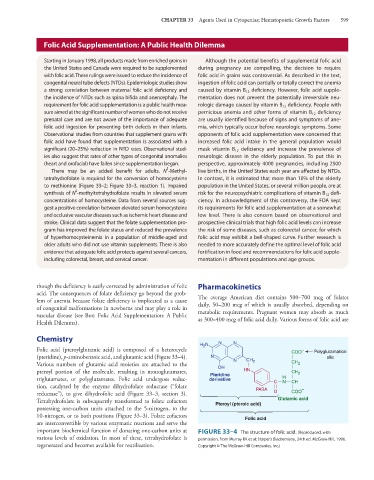Page 613 - Basic _ Clinical Pharmacology ( PDFDrive )
P. 613
CHAPTER 33 Agents Used in Cytopenias; Hematopoietic Growth Factors 599
Folic Acid Supplementation: A Public Health Dilemma
Starting in January 1998, all products made from enriched grains in Although the potential benefits of supplemental folic acid
the United States and Canada were required to be supplemented during pregnancy are compelling, the decision to require
with folic acid. These rulings were issued to reduce the incidence of folic acid in grains was controversial. As described in the text,
congenital neural tube defects (NTDs). Epidemiologic studies show ingestion of folic acid can partially or totally correct the anemia
a strong correlation between maternal folic acid deficiency and caused by vitamin B 12 deficiency. However, folic acid supple-
the incidence of NTDs such as spina bifida and anencephaly. The mentation does not prevent the potentially irreversible neu-
requirement for folic acid supplementation is a public health mea- rologic damage caused by vitamin B 12 deficiency. People with
sure aimed at the significant number of women who do not receive pernicious anemia and other forms of vitamin B 12 deficiency
prenatal care and are not aware of the importance of adequate are usually identified because of signs and symptoms of ane-
folic acid ingestion for preventing birth defects in their infants. mia, which typically occur before neurologic symptoms. Some
Observational studies from countries that supplement grains with opponents of folic acid supplementation were concerned that
folic acid have found that supplementation is associated with a increased folic acid intake in the general population would
significant (20–25%) reduction in NTD rates. Observational stud- mask vitamin B 12 deficiency and increase the prevalence of
ies also suggest that rates of other types of congenital anomalies neurologic disease in the elderly population. To put this in
(heart and orofacial) have fallen since supplementation began. perspective, approximately 4000 pregnancies, including 2500
5
There may be an added benefit for adults. N -Methyl- live births, in the United States each year are affected by NTDs.
tetrahydrofolate is required for the conversion of homocysteine In contrast, it is estimated that more than 10% of the elderly
to methionine (Figure 33–2; Figure 33–3, reaction 1). Impaired population in the United States, or several million people, are at
5
synthesis of N -methyltetrahydrofolate results in elevated serum risk for the neuropsychiatric complications of vitamin B 12 defi-
concentrations of homocysteine. Data from several sources sug- ciency. In acknowledgment of this controversy, the FDA kept
gest a positive correlation between elevated serum homocysteine its requirements for folic acid supplementation at a somewhat
and occlusive vascular diseases such as ischemic heart disease and low level. There is also concern based on observational and
stroke. Clinical data suggest that the folate supplementation pro- prospective clinical trials that high folic acid levels can increase
gram has improved the folate status and reduced the prevalence the risk of some diseases, such as colorectal cancer, for which
of hyperhomocysteinemia in a population of middle-aged and folic acid may exhibit a bell-shaped curve. Further research is
older adults who did not use vitamin supplements. There is also needed to more accurately define the optimal level of folic acid
evidence that adequate folic acid protects against several cancers, fortification in food and recommendations for folic acid supple-
including colorectal, breast, and cervical cancer. mentation in different populations and age groups.
though the deficiency is easily corrected by administration of folic Pharmacokinetics
acid. The consequences of folate deficiency go beyond the prob- The average American diet contains 500–700 mcg of folates
lem of anemia because folate deficiency is implicated as a cause daily, 50–200 mcg of which is usually absorbed, depending on
of congenital malformations in newborns and may play a role in metabolic requirements. Pregnant women may absorb as much
vascular disease (see Box: Folic Acid Supplementation: A Public as 300–400 mcg of folic acid daily. Various forms of folic acid are
Health Dilemma).
Chemistry
H N N N
2
Folic acid (pteroylglutamic acid) is composed of a heterocycle COO – Polyglutamation
(pteridine), p-aminobenzoic acid, and glutamic acid (Figure 33–4). N CH site
Various numbers of glutamic acid moieties are attached to the N 2 CH 2
pteroyl portion of the molecule, resulting in monoglutamates, OH HN CH 2
Pteridine
triglutamates, or polyglutamates. Folic acid undergoes reduc- derivative C H CH
N
tion, catalyzed by the enzyme dihydrofolate reductase (“folate
reductase”), to give dihydrofolic acid (Figure 33–3, section 3). PABA O COO –
Tetrahydrofolate is subsequently transformed to folate cofactors Pteroyl (pteroic acid) Glutamic acid
possessing one-carbon units attached to the 5-nitrogen, to the
10-nitrogen, or to both positions (Figure 33–3). Folate cofactors Folic acid
are interconvertible by various enzymatic reactions and serve the
important biochemical function of donating one-carbon units at FIGURE 33–4 The structure of folic acid. (Reproduced, with
various levels of oxidation. In most of these, tetrahydrofolate is permission, from Murray RK et al: Harper’s Biochemistry, 24th ed. McGraw-Hill, 1996.
regenerated and becomes available for reutilization. Copyright © The McGraw-Hill Companies, Inc.)

